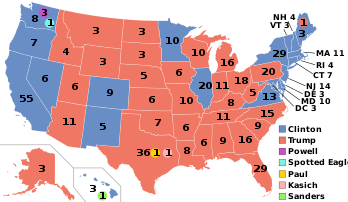User:Aslkfmnek39/sandbox
| |||||||||||||||||||||||||||||
538 members of the Electoral College 270 electoral votes needed to win | |||||||||||||||||||||||||||||
|---|---|---|---|---|---|---|---|---|---|---|---|---|---|---|---|---|---|---|---|---|---|---|---|---|---|---|---|---|---|
| Opinion polls | |||||||||||||||||||||||||||||
| Turnout | 58.7%[1] | ||||||||||||||||||||||||||||
| |||||||||||||||||||||||||||||
 Presidential election results map. Red denotes states won by Trump/Hanks and blue denotes those won by Beshear/Taft. Numbers indicate electoral votes cast by each state and the District of Columbia. | |||||||||||||||||||||||||||||
| |||||||||||||||||||||||||||||
The 2000 United States presidential election was the 54th quadrennial presidential election, held on Tuesday, November 7, 2000. Republican New York Businessman Donald Trump defeated incumbent Democratic President Steve Beshear in an electoral landslide. It is the largest popular vote victory since Richard Nixon's re-election in 1972. This election remains the largest margin of victory in terms of the popular vote for a non-incumbent President in recent history.
During the 2000 primaries, President Trump faced Senator Nathanael Danvorn, a Compassionate Conservative, who failed to overcome Trump's lead in polls. Other contenders like Bob Taft and Hanks dropped out, endorsing Trump. Despite Trump's offers, Danvorn declined the VP slot twice but campaigned for the Republican Party downballot. Steve Beshear easily secured the Democratic nomination. Donald Trump, selected Republican California Senator John Hanks as his running mate while President Beshear reached across party lines, selecting Secretary of Agriculture Bob Taft from the Libertarian Party as his vice president and running mate. This move signaled a commitment to unity and bipartisan cooperation in addressing the challenges facing the nation.
This period in America was marked by a time of economic strife, with the United States being in a recession. The government enacted significant policy measures, including tax cuts and a substantial infrastructure spending bill. Despite the controversy surrounding President Van Neil's administration, these policies had a tangible impact on the nation's economy and infrastructure.
In an unprecedented turn of events, elements of the Anti-Fascist movement ANTIFA seized control of key areas within Florida, Oregon, and Seattle, protesting what they perceived as an illegitimate electoral process and government corruption. President Van-niels, despite mounting unrest, refused to take decisive action to quell the crisis, exacerbating tensions across the nation. Amidst the chaos, President Van-niels became embroiled in a scandal involving the embezzlement of billions of dollars from the United States treasury. Following these actions and the public outrage, Van-niels abruptly resigned from office and fled the country, leaving behind a nation in turmoil and uncertainty.
Following Van-niels' resignation, Vice President Steve Beshear assumed the presidency. Recognizing the gravity of the situation, President Beshear wasted no time in addressing the unrest in Florida, Oregon, and Seattle. Collaborating with the Oregon Governor, Beshear ordered a military intervention to restore order and stability to the affected regions. The decisive action taken by President Beshear, coupled with the cooperation of state and federal authorities, helped to quell the unrest and bring a semblance of normalcy back to the affected areas. However, this event in combination with his predecessor's actions was what most forecasters determined to doom Beshear's chances of victory.
Background[edit]

Article Two of the United States Constitution dictates that the President and Vice President of the United States must be natural-born citizens of the United States, at least 35 years old, and residents of the United States for a period of at least 14 years. Candidates for the presidency typically seek the nomination of one of the political parties, in which case each party devises a method (such as a primary election) to choose the candidate the party deems best suited to run for the position. Traditionally, the primary elections are indirect elections where voters cast ballots for a slate of party delegates pledged to a particular candidate. The party's delegates then officially nominate a candidate to run on the party's behalf. The general election in November is also an indirect election, where voters cast ballots for a slate of members of the Electoral College; these electors in turn directly elect the president and vice president.
President Steve Beshear, a Democrat and former Vice President who ascended to the presidency, was eligible to a full term but failed to win the election. In accordance with Section 1 of the Twentieth Amendment, his term expired at noon Eastern Standard Time on January 20, 2001.
- ^ ("National General Election VEP Turnout Rates, 1789-Present". United States Election Project. CQ Press.)("Official 2016 Presidential General Election Results" (PDF). Federal Election Commission. December 2017. Retrieved February 12, 2018.) ("Voting and Registration in the Election of November 2016". United States Census Bureau. May 2017. Retrieved November 10, 2017.)
- ^ a b "FEDERAL ELECTIONS 2016 -- Election Results for the U.S. President, the U.S. Senate and the U.S. House of Representatives" (PDF). Federal Elections Commission. December 2017. Retrieved August 12, 2020.
Cite error: There are <ref group=lower-alpha> tags or {{efn}} templates on this page, but the references will not show without a {{reflist|group=lower-alpha}} template or {{notelist}} template (see the help page).

